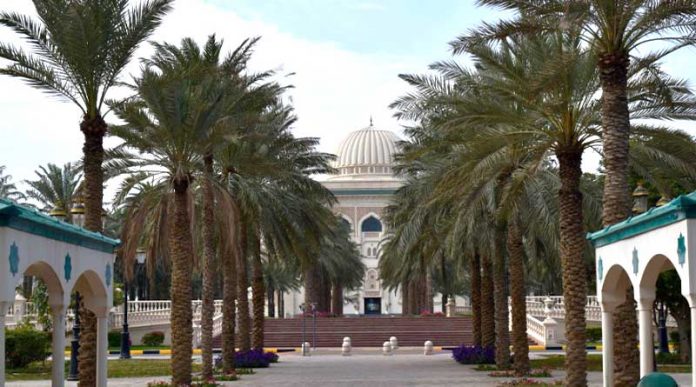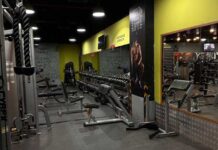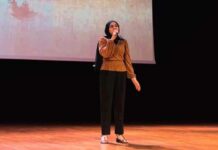
Architecture students explain certain processes of architecture in the UAE.
By Zehra Qureshi
UNIVERSITY CITY, SHARJAH – The future of design in the United Arab Emirates is here, and the history behind it is timeless.
From being a cluster of villages in the middle of the desert to one of the most developed places in the world, the UAE has come far.
Sabiha Ameen, a third-year architecture student at AUS said, “It is so innovative. There is no challenge that they back away from.”
In the midst of all of this, architecture’s newest innovators have a role to play in furthering the development.
Ameen is originally from Chennai, India. She aspires to major in sustainable urban design. What inspired her to become an architect came from her wish to “think and work holistically.”
Ryam Almehemdi is another student studying architecture at AUS. She is from Iraq. Her personal style of architecture is seen through geometric designs and the use of parametric that “relies heavily on creating atmospheres and visual, tactile experiences.”
Almehemdi said, “Good architecture comes with power, power to sway the public opinion on certain matters or bring attention to certain matters.”
Almehemdi has a history of working on residential, civic areas and pavilions.
Dinisha Dinesh, another future architect at AUS, wants to place a concentration on robotics and AI in her work. Dinesh adds that she would like to conduct research toward enabling architecture to be able to increase its durability against natural calamities. She has lived in Dubai for around 22 years.
Dinesh said, “My interest in architecture really emerged in my first year of college. I really liked the part where it’s kind of like a puzzle and there’s this immense satisfaction that kind of comes from seeing this 2D of a very abstract idea becoming this very solid real-life thing.”
Another student of architecture at AUS, Ranjeet George said, “Unlike other majors, architecture is a discipline that is not a repetitive work.”
George included, “Whenever we do a project in the UAE, we start off by doing a site analysis in which we research and study the context of the product.”
George continued that by doing this the architects can have a better understanding of how to construct the project and come up against problems that the project may encounter in consideration of the context.
Soha Abdalgawad is one more student at AUS who is also majoring in architecture from Egypt. She describes her architectural style as being modernist. She has a fondness for “simple geometry and spatial arrangement.”
“I have a love for drawing, designing, and physical object-making or hand-crafting,” Abdalgawad included.
What exactly marks the characteristics of architecture in the UAE? The list is endless. For example, certain differences in architecture can be marked in different regions of the UAE.
Dinesh said, “In Dubai, you’d see more of skyscrapers whereas, in Abu Dhabi, it is more of a shorter stereotomic architecture.”
Stereotomic architecture refers to the diminution of rigid shapes. Stereotomic can be divided into two parts known as Greek roots. The definition of the root ‘Stereo’ is three-dimensional and the other root ‘Tomos’ can be defined as “to cut” as stated by the website Artefacts.
Ameen said, “As much as UAE focuses on expanding its western modernist architectural style, it also makes sure to pay homage to its traditional values and vernacular architecture and thereby achieves its own form of modernity.”
Vernacular architecture refers to a kind of native or geographical architecture that utilizes items and assets that are located in the place where the building is being constructed according to the website Arch Daily.
Ameen said, “UAE isn’t afraid to move beyond the traditional ways of architecture.”
George added, “Generally the buildings follow modern designs, modern shapes, mainly having glass and metal facades.
George added that Sharjah to a large extent has traditional Arabic architecture. He said this traditional structure showcases arches and has inspiration from “local architecture.”
Almehemdi said the materials used for architecture in the UAE are fundamentally concrete and the buildings made are usually tall ones.
Abdalgawad said that a certain amount of material for buildings in the UAE is found in the use of coral walls, which is found locally.
.
Given the fact that the UAE is extremely hot on most occasions, the probability of temperature playing a large factor in how buildings are constructed is high.
Dinesh had plenty to say about this discussion. She agrees that temperature plays an important role when creating any building in this region. Something that architects work on is analyzing the amount of heat generated from the space used.
Dinesh added, “Using a lot of glass in projects can contribute to a lot of heat being produced within a space.”
She explained that this leads to people being inclined to turn the AC on and use cooling methods, which are where most of the energy is being generated.
“All of the energy over here is kind of derived from burning fossil fuels and petrol,” she added.
She said that the increased usage of electricity leads to the increase of using natural resources and assists in advancing climate change. Dinesh said that one aim of architects is to develop a space that has natural airing and is a colder area to enable people to not need to use the AC any longer.
Speaking of the utilization of energy and natural resources, sustainable buildings have become a more viable option when looking at creating structures.
Ameen offers a detailed solution in terms of utilizing sustainability in building projects. Ameen said that by incorporating the four elements of earth, air, fire and water and using materials found locally in the design process, sustainable buildings can be achieved.
Ameen added examples of using the four elements. Water can be made use of by implementing it in “passive heating in floors” in chillier places or for reducing heat in places with higher temperatures. Fire relates to undeviating warming practices. Air is utilized through “stack or cross-ventilation” to decrease air conditioning. Finally, passive cooling in spaces below ground is related to the earth element.
“Another way to build sustainably is to think about the process of construction and how to reuse the formwork or the waste materials of the project,” Ameen included.
Abdalgawad said that there are a number of methods that architects and designers can use in relation to sustainable buildings. She said that wood is an example of a local material that does not fade easily.
Abdalgawad added, “Some architects design buildings that can be easily changed to suit different functions so the building can last longer.”
George said, “We have to design buildings that promote the use of renewable energy, reduce energy consumption, and use other ideas that encourage sustainability.”
It is safe to say that the future of architecture in the UAE is in good hands.

















